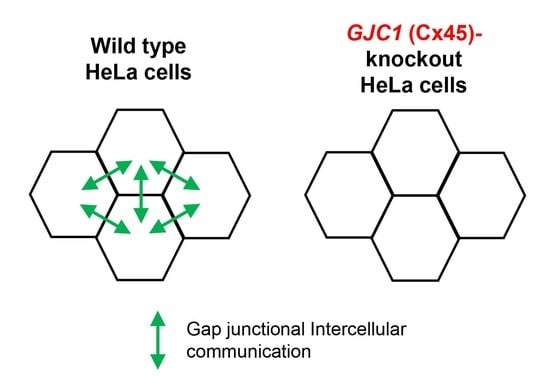Confirmation of Connexin45 Underlying Weak Gap Junctional Intercellular Coupling in HeLa Cells
Abstract
:1. Introduction
2. Materials and Methods
2.1. Reagent
2.2. Cell Culture
2.3. Constructs
2.4. Lentiviral Production and Transduction
2.5. I-YFP GJIC Assay
2.6. Reverse Transcription-Polymerase Chain Reaction (RT-PCR)
2.7. T7E1 Assay
2.8. Immunoblot Analysis
2.9. Measurement of Junctional Conductance (Gj) and its Dependence on Junctional Potential (Vj)
2.10. Statistical Analyses
3. Results
3.1. Functional Expression of Endogenous GJs in HeLa Cells
3.2. Identification of Cx45 as a Major Cx Isotype in HeLa Cells
3.3. Electrophysiological Measurement of GJ Activity in HeLa Cells
3.4. Identification of the Cx Responsible for GJIC in A549 Cells
4. Discussion
5. Conclusions
Supplementary Materials
Author Contributions
Funding
Conflicts of Interest
References
- Alexander, D.B.; Goldberg, G.S. Transfer of biologically important molecules between cells through gap junction channels. Curr. Med. Chem. 2003, 10, 2045–2058. [Google Scholar] [CrossRef] [PubMed]
- Makowski, L.; Caspar, D.L.; Phillips, W.C.; Baker, T.S.; Goodenough, D.A. Gap junction structures. Vi. Variation and conservation in connexon conformation and packing. Biophys. J. 1984, 45, 208–218. [Google Scholar] [CrossRef] [Green Version]
- Willecke, K.; Jungbluth, S.; Dahl, E.; Hennemann, H.; Heynkes, R.; Grzeschik, K.H. Six genes of the human connexin gene family coding for gap junctional proteins are assigned to four different human chromosomes. Eur. J. Cell Biol. 1990, 53, 275–280. [Google Scholar] [PubMed]
- Willecke, K.; Eiberger, J.; Degen, J.; Eckardt, D.; Romualdi, A.; Guldenagel, M.; Deutsch, U.; Sohl, G. Structural and functional diversity of connexin genes in the mouse and human genome. Biol. Chem. 2002, 383, 725–737. [Google Scholar] [CrossRef] [PubMed]
- Srinivas, M.; Verselis, V.K.; White, T.W. Human diseases associated with connexin mutations. Biochim. Biophys. Acta Biomembr. 2018, 1860, 192–201. [Google Scholar] [CrossRef]
- Sundset, R.; Cooper, M.; Mikalsen, S.O.; Ytrehus, K. Ischemic preconditioning protects against gap junctional uncoupling in cardiac myofibroblasts. Cell Commun. Adhes. 2004, 11, 51–66. [Google Scholar] [CrossRef]
- Ruiz-Meana, M.; Garcia-Dorado, D.; Lane, S.; Pina, P.; Inserte, J.; Mirabet, M.; Soler-Soler, J. Persistence of gap junction communication during myocardial ischemia. Am. J. Physiol. Heart Circ. Physiol. 2001, 280, H2563–H2571. [Google Scholar] [CrossRef]
- Hawat, G.; Benderdour, M.; Rousseau, G.; Baroudi, G. Connexin 43 mimetic peptide gap26 confers protection to intact heart against myocardial ischemia injury. Pflugers Arch. 2010, 460, 583–592. [Google Scholar] [CrossRef]
- Valiante, T.A.; Perez Velazquez, J.L.; Jahromi, S.S.; Carlen, P.L. Coupling potentials in ca1 neurons during calcium-free-induced field burst activity. J. Neurosci. 1995, 15, 6946–6956. [Google Scholar] [CrossRef] [Green Version]
- Mylvaganam, S.; Ramani, M.; Krawczyk, M.; Carlen, P.L. Roles of gap junctions, connexins, and pannexins in epilepsy. Front. Physiol. 2014, 5, 172. [Google Scholar] [CrossRef] [Green Version]
- Alves, L.A.; de Carvalho, A.C.; Savino, W. Gap junctions: A novel route for direct cell-cell communication in the immune system? Immunol. Today 1998, 19, 269–275. [Google Scholar] [CrossRef]
- Sáez, J.C.; Araya, R.; Brañes, M.C.; Concha, M.; Contreras, J.E.; Eugenín, E.A.; Martinez, A.D.; Palisson, F.; Sepúlveda, M.A. Chapter 25: Gap junctions in inflammatory responses: Connexins, regulation and possible functional roles. Curr. Top. Membr. 1999, 49, 555–579. [Google Scholar]
- Takeuchi, H.; Mizoguchi, H.; Doi, Y.; Jin, S.; Noda, M.; Liang, J.; Li, H.; Zhou, Y.; Mori, R.; Yasuoka, S.; et al. Blockade of gap junction hemichannel suppresses disease progression in mouse models of amyotrophic lateral sclerosis and alzheimer’s disease. PLoS ONE 2011, 6, e21108. [Google Scholar] [CrossRef] [PubMed] [Green Version]
- Abbaci, M.; Barberi-Heyob, M.; Blondel, W.; Guillemin, F.; Didelon, J. Advantages and limitations of commonly used methods to assay the molecular permeability of gap junctional intercellular communication. Biotechniques 2008, 45, 33–62. [Google Scholar] [CrossRef]
- Stewart, W.W. Functional connections between cells as revealed by dye-coupling with a highly fluorescent naphthalimide tracer. Cell 1978, 14, 741–759. [Google Scholar] [CrossRef]
- El-Fouly, M.H.; Trosko, J.E.; Chang, C.C. Scrape-loading and dye transfer. A rapid and simple technique to study gap junctional intercellular communication. Exp. Cell Res. 1987, 168, 422–430. [Google Scholar] [CrossRef]
- Wilders, R.; Jongsma, H.J. Limitations of the dual voltage clamp method in assaying conductance and kinetics of gap junction channels. Biophys. J. 1992, 63, 942–953. [Google Scholar] [CrossRef] [Green Version]
- Lee, J.Y.; Choi, E.J.; Lee, J. A new high-throughput screening-compatible gap junctional intercellular communication assay. BMC Biotechnol. 2015, 15, 90. [Google Scholar] [CrossRef] [Green Version]
- Dydowiczova, A.; Brozman, O.; Babica, P.; Sovadinova, I. Improved multiparametric scrape loading-dye transfer assay for a simultaneous high-throughput analysis of gap junctional intercellular communication, cell density and viability. Sci. Rep. 2020, 10, 730. [Google Scholar] [CrossRef] [Green Version]
- Eckert, R.; Dunina-Barkovskaya, A.; Hulser, D.F. Biophysical characterization of gap-junction channels in hela cells. Pflugers Arch. 1993, 424, 335–342. [Google Scholar] [CrossRef] [Green Version]
- Butterweck, A.; Gergs, U.; Elfgang, C.; Willecke, K.; Traub, O. Immunochemical characterization of the gap junction protein connexin45 in mouse kidney and transfected human hela cells. J. Membr. Biol. 1994, 141, 247–256. [Google Scholar] [CrossRef] [PubMed]
- Kameritsch, P.; Khandoga, N.; Pohl, U.; Pogoda, K. Gap junctional communication promotes apoptosis in a connexin-type-dependent manner. Cell Death Dis. 2013, 4, 584. [Google Scholar] [CrossRef] [PubMed]
- Toyofuku, T.; Yabuki, M.; Otsu, K.; Kuzuya, T.; Hori, M.; Tada, M. Intercellular calcium signaling via gap junction in connexin-43-transfected cells. J. Biol. Chem. 1998, 273, 1519–1528. [Google Scholar] [CrossRef] [PubMed] [Green Version]
- Galietta, L.J.; Haggie, P.M.; Verkman, A.S. Green fluorescent protein-based halide indicators with improved chloride and iodide affinities. FEBS Lett. 2001, 499, 220–224. [Google Scholar] [CrossRef] [Green Version]
- Saitoh, K.; Chen, W.J. Reducing cloning artifacts for recovery of allelic sequences by t7 endonuclease i cleavage and single re-extension of pcr products—a benchmark. Gene 2008, 423, 92–95. [Google Scholar] [CrossRef] [PubMed]
- Spray, D.C.; Harris, A.L.; Bennett, M.V. Equilibrium properties of a voltage-dependent junctional conductance. J. Gen. Physiol. 1981, 77, 77–93. [Google Scholar] [CrossRef] [PubMed] [Green Version]
- Choi, E.J.; Yeo, J.H.; Yoon, S.M.; Lee, J. Gambogic acid and its analogs inhibit gap junctional intercellular communication. Front. Pharmacol. 2018, 9, 814. [Google Scholar] [CrossRef]
- Yeo, J.H.; Choi, E.J.; Lee, J. Inhibition of gap junctional intercellular communication by an anti-migraine agent, flunarizine. PLoS ONE 2019, 14, e0222326. [Google Scholar] [CrossRef] [Green Version]
- Lee, J.Y.; Yoon, S.M.; Choi, E.J.; Lee, J. Terbinafine inhibits gap junctional intercellular communication. Toxicol. Appl. Pharmacol. 2016, 307, 102–107. [Google Scholar] [CrossRef]
- Kandouz, M.; Bier, A.; Carystinos, G.D.; Alaoui-Jamali, M.A.; Batist, G. Connexin43 pseudogene is expressed in tumor cells and inhibits growth. Oncogene 2004, 23, 4763–4770. [Google Scholar] [CrossRef] [Green Version]
- Bae, S.; Park, J.; Kim, J.S. Cas-offinder: A fast and versatile algorithm that searches for potential off-target sites of cas9 rna-guided endonucleases. Bioinformatics 2014, 30, 1473–1475. [Google Scholar] [CrossRef] [Green Version]
- Chanson, M.; Chandross, K.J.; Rook, M.B.; Kessler, J.A.; Spray, D.C. Gating characteristics of a steeply voltage-dependent gap junction channel in rat schwann cells. J. Gen. Physiol. 1993, 102, 925–946. [Google Scholar] [CrossRef] [PubMed] [Green Version]
- Werner, R. Gap Junctions: Proceedings of the 8th International Gap Junction Conference, Key Largo, Florida; IOS Press: Amsterdam, The Netherlands, 1998; pp. 25–29. [Google Scholar]
- Huang, Y.S.; Tseng, Y.Z.; Wu, J.C.; Wang, S.M. Mechanism of oleic acid-induced gap junctional disassembly in rat cardiomyocytes. J. Mol. Cell Cardiol. 2004, 37, 755–766. [Google Scholar] [CrossRef] [PubMed]
- Sahu, G.; Sukumaran, S.; Bera, A.K. Pannexins form gap junctions with electrophysiological and pharmacological properties distinct from connexins. Sci. Rep. 2014, 4, 4955. [Google Scholar] [CrossRef] [PubMed] [Green Version]
- Sohl, G.; Willecke, K. An update on connexin genes and their nomenclature in mouse and man. Cell Commun. Adhes. 2003, 10, 173–180. [Google Scholar] [CrossRef]
- Moreno, A.P.; Laing, J.G.; Beyer, E.C.; Spray, D.C. Properties of gap junction channels formed of connexin 45 endogenously expressed in human hepatoma (skhep1) cells. Am. J. Physiol. 1995, 268, C356–C365. [Google Scholar] [CrossRef] [Green Version]
- Bukauskas, F.F.; Angele, A.B.; Verselis, V.K.; Bennett, M.V. Coupling asymmetry of heterotypic connexin 45/ connexin 43-egfp gap junctions: Properties of fast and slow gating mechanisms. Proc. Natl. Acad. Sci. USA 2002, 99, 7113–7118. [Google Scholar] [CrossRef] [Green Version]
- Liu, Y.; Mi, Y.; Mueller, T.; Kreibich, S.; Williams, E.G.; Van Drogen, A.; Borel, C.; Frank, M.; Germain, P.L.; Bludau, I.; et al. Multi-omic measurements of heterogeneity in hela cells across laboratories. Nat. Biotechnol. 2019, 37, 314–322. [Google Scholar] [CrossRef]
- Zhang, Z.Q.; Hu, Y.; Wang, B.J.; Lin, Z.X.; Naus, C.C.; Nicholson, B.J. Effective asymmetry in gap junctional intercellular communication between populations of human normal lung fibroblasts and lung carcinoma cells. Carcinogenesis 2004, 25, 473–482. [Google Scholar] [CrossRef] [Green Version]
- Geletu, M.; Arulanandam, R.; Greer, S.; Trotman-Grant, A.; Tomai, E.; Raptis, L. Stat3 is a positive regulator of gap junctional intercellular communication in cultured, human lung carcinoma cells. BMC Cancer 2012, 12, 605. [Google Scholar] [CrossRef] [Green Version]
- Gros, D.B.; Jongsma, H.J. Connexins in mammalian heart function. Bioessays 1996, 18, 719–730. [Google Scholar] [CrossRef]
- Hanner, F.; von Maltzahn, J.; Maxeiner, S.; Toma, I.; Sipos, A.; Kruger, O.; Willecke, K.; Peti-Peterdi, J. Connexin45 is expressed in the juxtaglomerular apparatus and is involved in the regulation of renin secretion and blood pressure. Am. J. Physiol. Regul. Integr. Comp. Physiol. 2008, 295, R371–R380. [Google Scholar] [CrossRef] [PubMed] [Green Version]
- Li, X.; Kamasawa, N.; Ciolofan, C.; Olson, C.O.; Lu, S.; Davidson, K.G.; Yasumura, T.; Shigemoto, R.; Rash, J.E.; Nagy, J.I. Connexin45-containing neuronal gap junctions in rodent retina also contain connexin36 in both apposing hemiplaques, forming bihomotypic gap junctions, with scaffolding contributed by zonula occludens-1. J. Neurosci. 2008, 28, 9769–9789. [Google Scholar] [CrossRef] [PubMed]
- Maxeiner, S.; Dedek, K.; Janssen-Bienhold, U.; Ammermuller, J.; Brune, H.; Kirsch, T.; Pieper, M.; Degen, J.; Kruger, O.; Willecke, K.; et al. Deletion of connexin45 in mouse retinal neurons disrupts the rod/cone signaling pathway between aii amacrine and on cone bipolar cells and leads to impaired visual transmission. J. Neurosci. 2005, 25, 566–576. [Google Scholar] [CrossRef] [PubMed]
- Khodosevich, K.; Zuccotti, A.; Kreuzberg, M.M.; Le Magueresse, C.; Frank, M.; Willecke, K.; Monyer, H. Connexin45 modulates the proliferation of transit-amplifying precursor cells in the mouse subventricular zone. Proc. Natl. Acad. Sci. USA 2012, 109, 20107–20112. [Google Scholar] [CrossRef] [PubMed] [Green Version]
- Marins, M.; Xavier, A.L.; Viana, N.B.; Fortes, F.S.; Froes, M.M.; Menezes, J.R. Gap junctions are involved in cell migration in the early postnatal subventricular zone. Dev. Neurobiol. 2009, 69, 715–730. [Google Scholar] [CrossRef]
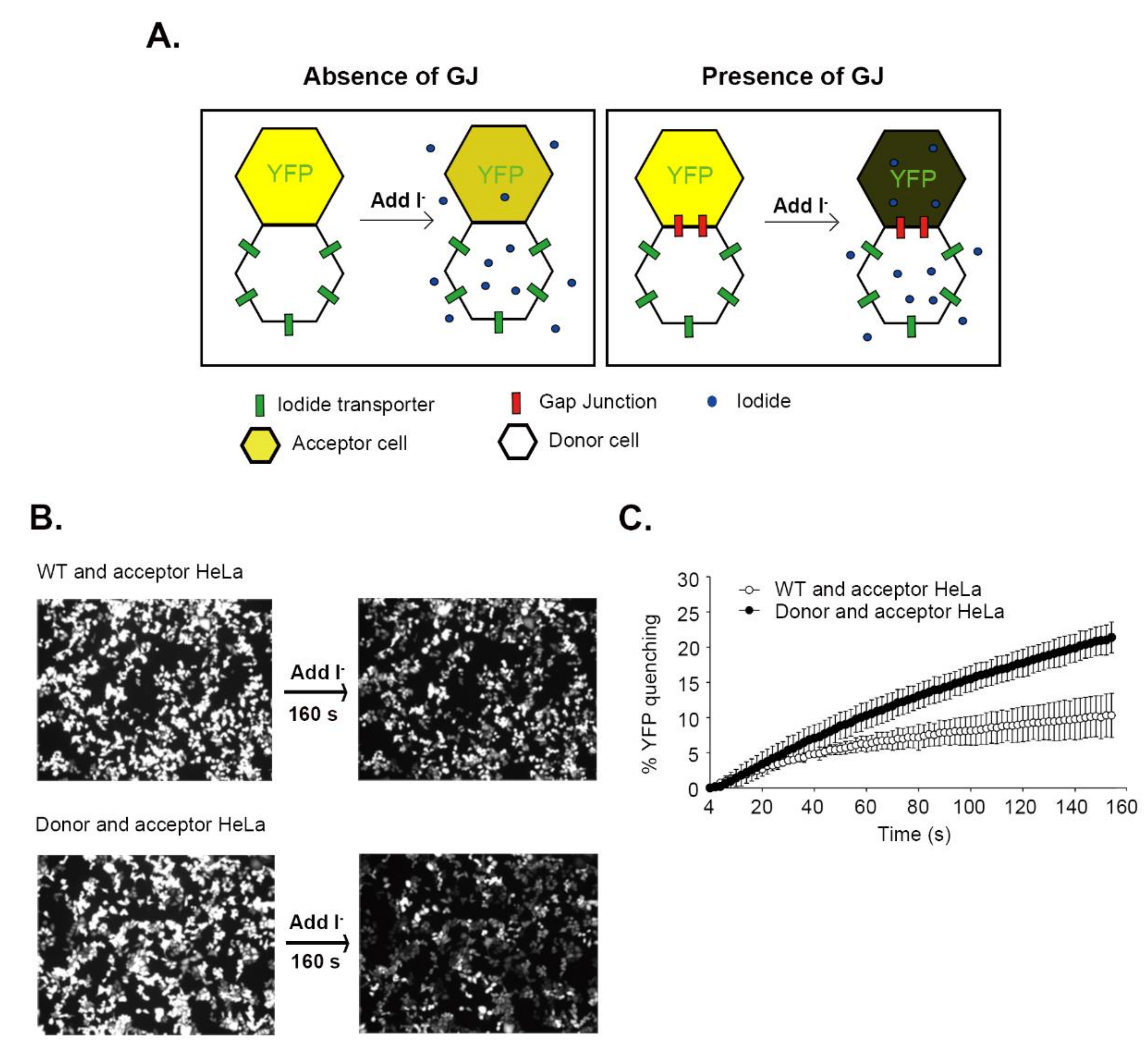
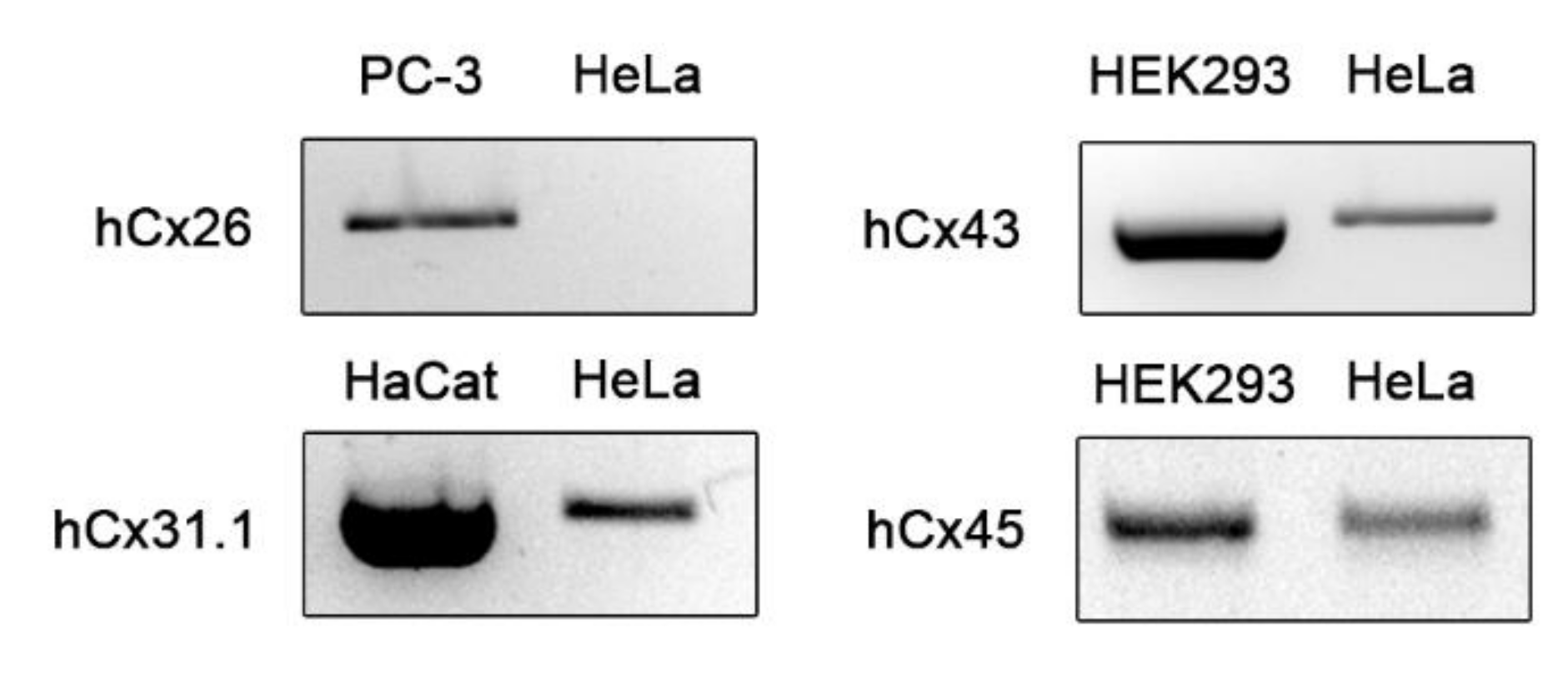
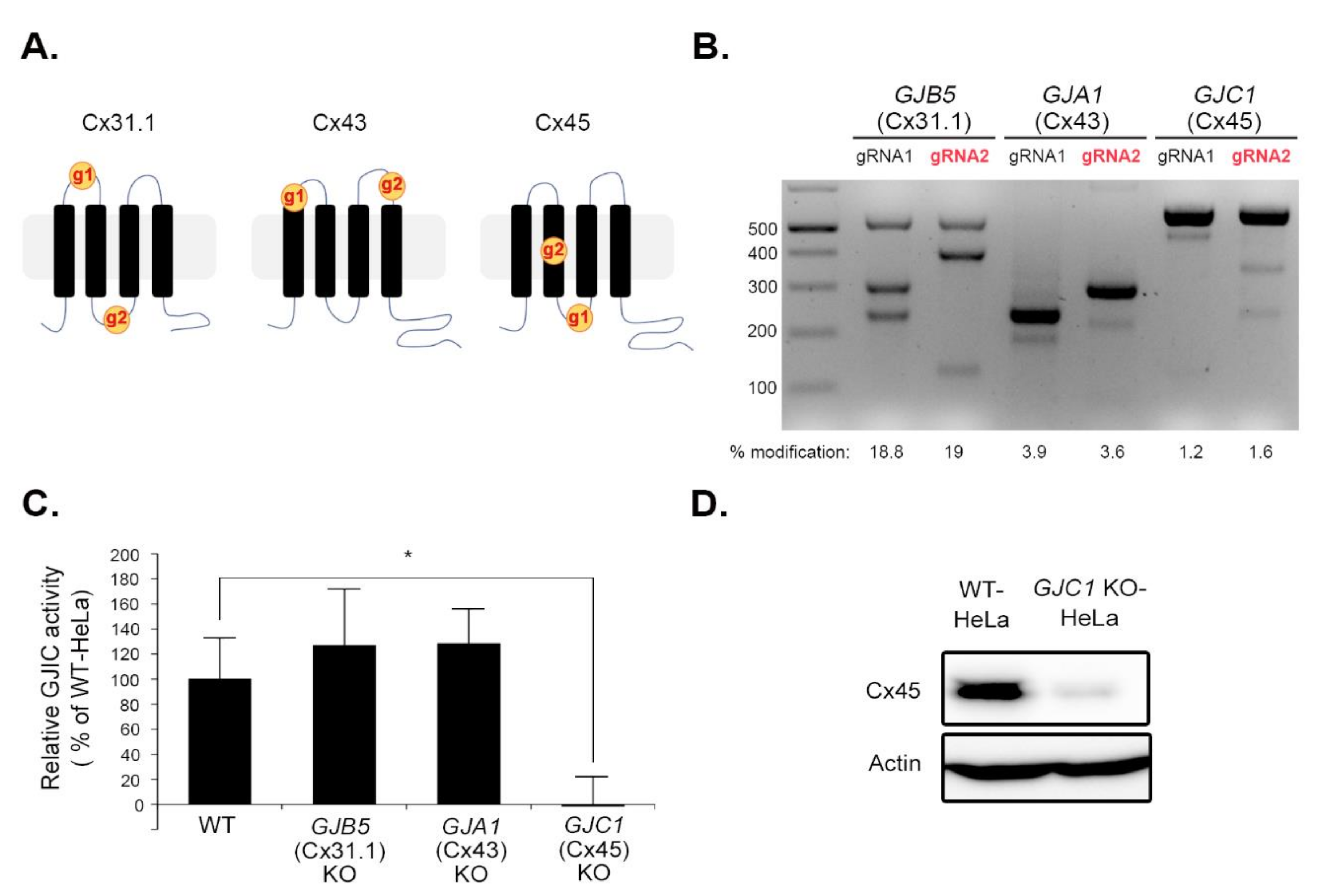
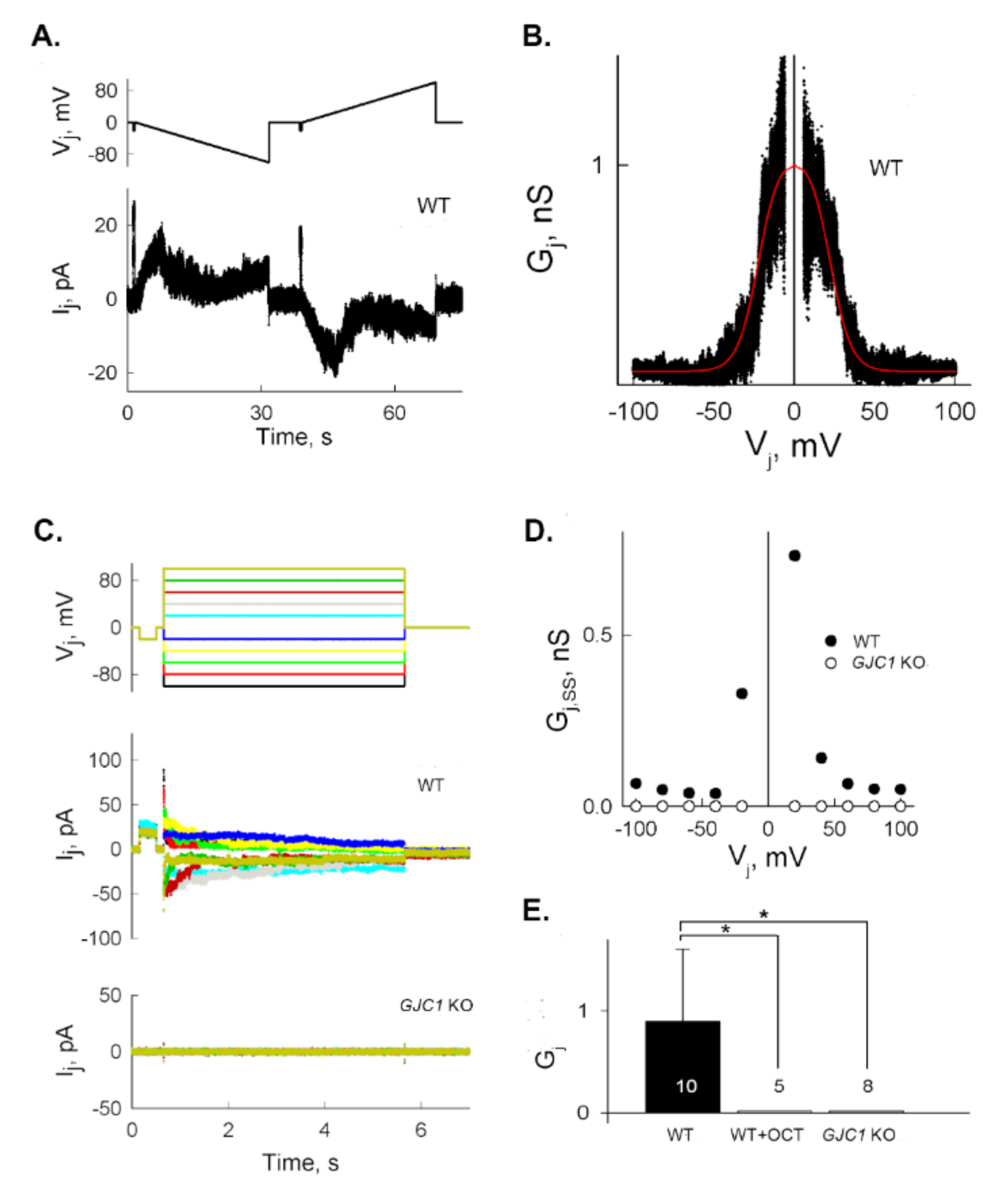
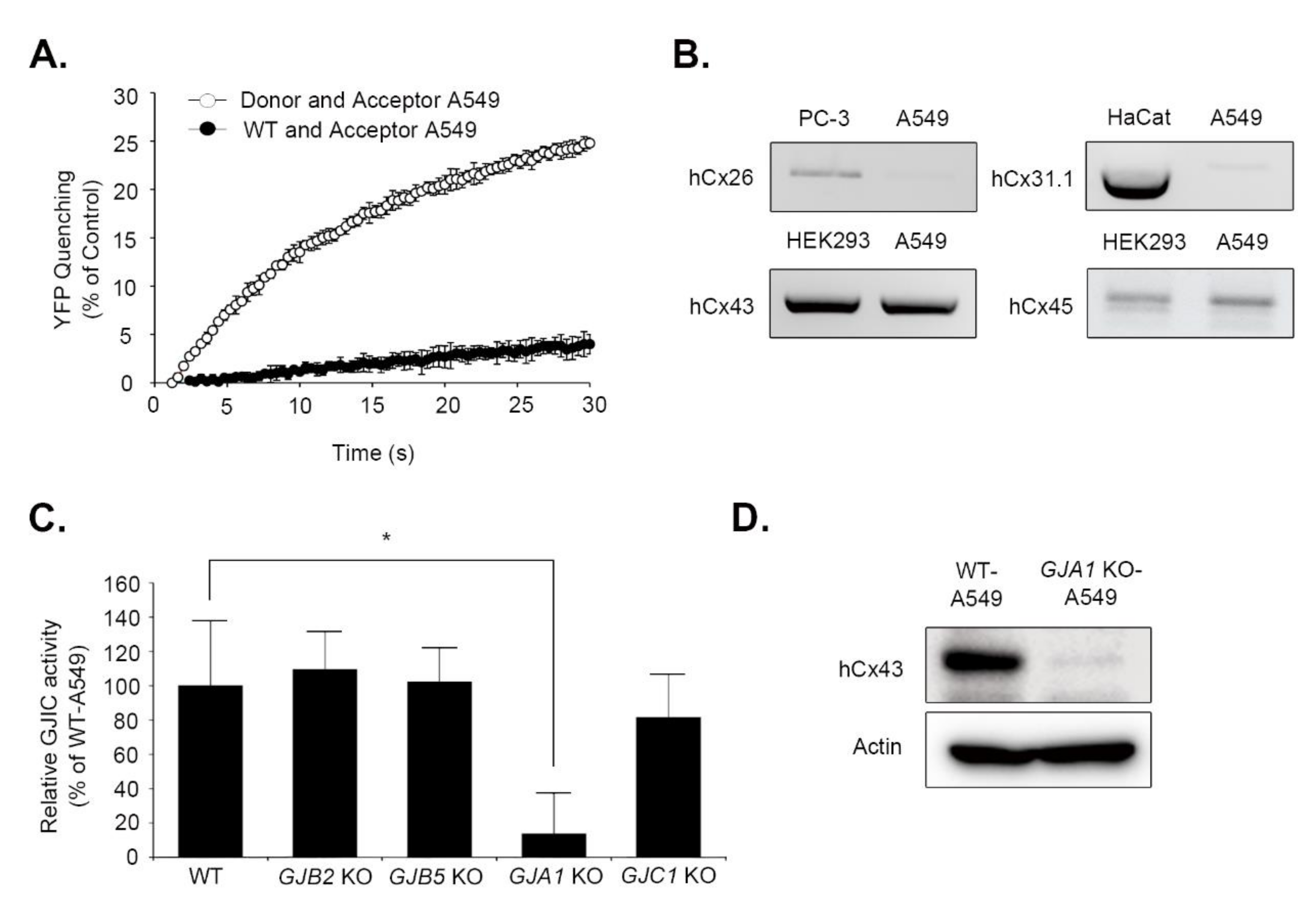
| sgRNA | Sequences |
|---|---|
| GJB2 (Cx26) gRNA1 | sense: 5′-CACCGCCTCCTTTGCAGCCACAACG-3′ |
| antisense: 5′-AAACCGTTGTGGCTGCAAAGGAGGC-3′ | |
| GJB2 (Cx26) gRNA2 | sense: 5′-CACCGTCCACGCCAGCGCTCCTAG-3′ |
| antisense: 5′-AAACCTAGGAGCGCTGGCGTGGAC-3′ | |
| GJB5 (Cx31.1) gRNA1 | sense: 5′-CACCGAACTCATCAAAGCAGACGT-3′ |
| antisense: 5′-AAACACGTCTGCTTTGATGAGTTC-3′ | |
| GJB5 (Cx31.1) gRNA2 | sense: 5′-CACCGGGCGCCTCTACCTGAACCC-3′ |
| antisense: 5′-AAACGGGTTCAGGTAGAGGCGCCC-3′ | |
| GJA1 (Cx43) gRNA1 | sense: 5′-CACCGAATCCTGCTGCTGGGGACA-3′ |
| antisense: 5′-AAACCTGTCCCCAGCAGCAGGATT-3′ | |
| GJA1 (Cx43) gRNA2 | sense: 5′-CACCGTTTTCTCCGTGGGGCGAGAG-3′ |
| antisense: 5′-AAACCTCTCGCCCCACGGAGAAAA-3′ | |
| GJA1 (Cx43) gRNA3 | sense: 5′-CACCGCACCACTGGTCGCATGGTAA-3′ |
| antisense: 5′-AAACTTACCATGCGACCAGTGGTG-3′ | |
| GJC1 (Cx45) gRNA1 | sense: 5′-CACCGCTAAGCATGATGGCCGACGA-3′ |
| antisense: 5′-AAACTCGTCGGCCATCATGCTTAGC-3′ | |
| GJC1 (Cx45) gRNA2 | sense: 5′-CACCGATAGCCCAGGTACATCACAG-3′ |
| antisense: 5′-AAACCTGTGATGTACCTGGGCTATC-3′ |
| Target | Sequences | Amplicon Size |
|---|---|---|
| GJB2 (Cx26) | F: 5′-TTCCTCCCGACGCAGAGCAAAC-3′ | 428 bp |
| R: 5′-AGCCTTCGATGCGGACCTTCTG-3′ | ||
| GJB5 (Cx31.1) | F: 5′-GCTGCTTGCTGAGTCCTATTGCC-3′ | 514 bp |
| R: 5′-TCCACGCTCGCCTTGAACACTAG-3′ | ||
| GJA1 (Cx43) | F: 5′-AGGCGTGAGGAAAGTACCAAACAG-3′ | 461 bp |
| R: 5′-CGCATCACATAGAACACATGAGCCAG-3′ | ||
| GJC1 (Cx45) | F: 5′-AGGAGAGGCGAGGGTGAAGG-3′ | 545 bp |
| R: 5′-TCCGAGCTGCCTTCTTGTCTGC-3′ |
| Target Locus | Sequences | Amplicon Size |
|---|---|---|
| GJB2 (Cx26) gRNA1 & 2 | F: TGCTTACCCAGACTCAGAGAAG | 547 bp |
| R: ATGACATAGAAGACGTACATGAAG | ||
| GJB5 (Cx31.1) gRNA1 & 2 | F: TGTTCTTGTTTCCCTGCAGTAG | 527 bp |
| R: CCACAGGAGGGAGGATATATTTG | ||
| GJA1 (Cx43) gRNA1, 2, & 3 (outer PCR) | F: AGGGAAGGTGTGGCTGTCAGTAC | 1200 bp |
| R: ATAAGGCTGTTGAGTACCACC | ||
| GJA1 (Cx43) gRNA1 (inner PCR) | F: AGGGAAGGTGTGGCTGTCAGTAC | 204 bp |
| R: CGCATCACATAGAACACATGAGCCAG | ||
| GJA1 (Cx43) gRNA2 & 3 (inner PCR) | F: GTGGTACATCTATGGATTCAGCTTGAGTG | 303 bp |
| R: GGTGAGGAGCAGCCATTGAAATAAGC | ||
| GJC1 (Cx45) gRNA1 & 2 | F: TAGAGGAGATTCACAACCATTC | 590 bp |
| R: AAACGGGTGGACTTGGAAG |
© 2020 by the authors. Licensee MDPI, Basel, Switzerland. This article is an open access article distributed under the terms and conditions of the Creative Commons Attribution (CC BY) license (http://creativecommons.org/licenses/by/4.0/).
Share and Cite
Choi, E.J.; Palacios-Prado, N.; Sáez, J.C.; Lee, J. Confirmation of Connexin45 Underlying Weak Gap Junctional Intercellular Coupling in HeLa Cells. Biomolecules 2020, 10, 1389. https://doi.org/10.3390/biom10101389
Choi EJ, Palacios-Prado N, Sáez JC, Lee J. Confirmation of Connexin45 Underlying Weak Gap Junctional Intercellular Coupling in HeLa Cells. Biomolecules. 2020; 10(10):1389. https://doi.org/10.3390/biom10101389
Chicago/Turabian StyleChoi, Eun Ju, Nicolás Palacios-Prado, Juan C. Sáez, and Jinu Lee. 2020. "Confirmation of Connexin45 Underlying Weak Gap Junctional Intercellular Coupling in HeLa Cells" Biomolecules 10, no. 10: 1389. https://doi.org/10.3390/biom10101389
APA StyleChoi, E. J., Palacios-Prado, N., Sáez, J. C., & Lee, J. (2020). Confirmation of Connexin45 Underlying Weak Gap Junctional Intercellular Coupling in HeLa Cells. Biomolecules, 10(10), 1389. https://doi.org/10.3390/biom10101389






